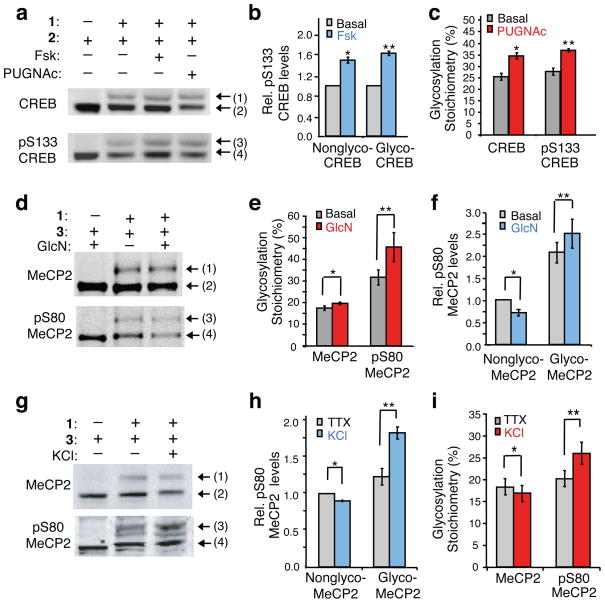Figure 4.
Dissecting the interplay between O-GlcNAc and phosphorylation. Detection of four subpopulations of CREB or MeCP2: glycosylated (1), nonglycosylated (2), glycosylated and phosphorylated (3), and nonglycosylated and phosphorylated (4). (a) CREB can be simultaneously glycosylated and phosphorylated. Mass-tagged lysates from 293T cells treated with Fsk, PUGNAc or vehicle were immunoblotted with a pS133-specific or general CREB antibody. (b) Fsk stimulates pS133 phosphorylation of glycosylated and non-glycosylated CREB similarly (n = 6). (c) Inhibition of OGA increases CREB glycosylation levels on phosphorylated and total CREB similarly (n = 4). Neither Fsk nor PUGNAc affected overall CREB glycosylation or pS133 phosphorylation levels, respectively (Supplementary Fig. 7). (d) Complex interplay between MeCP2 glycosylation and phosphorylation. Mass-tagged lysates from neurons treated with GlcN or vehicle were immunoblotted with a pS80-specific or general MeCP2 antibody (n = 6). (e) GlcN increases MeCP2 glycosylation levels predominantly on the pS80 subpopulation. (f) GlcN decreases pS80 levels on the nonglycosylated subpopulation and increases pS80 levels on the glycosylated subpopulation. (g) Reverse yin-yang relationship on MeCP2 under physiological conditions. Mass-tagged nuclear extracts from synchronously depolarized or non-depolarized neurons were immunoblotted with a pS80-specific or general MeCP2 antibody (n = 8). (h) Neuronal depolarization induces pS80 levels on glycosylated MeCP2. (i) Depolarization increases the glycosylation level of pS80 MeCP2, while decreasing that of total MeCP2. UDP ketogalactose 1 was excluded as a control. Data represent mean ± s.e.m. Statistics were analyzed by Student’s t-test. * P = 0.0005, ** P = 0.00007 for (b). * P = 0.02, ** P = 0.0007 for (c). * P = 0.04, ** P = 0.008 for (e). * P = 0.01, ** P = 0.04 for (f). * P = 0.01, ** P = 0.001 for (h). * P = 0.04, ** P = 0.001 for (i). Full-length blots are presented in Supplementary Figure 9.

